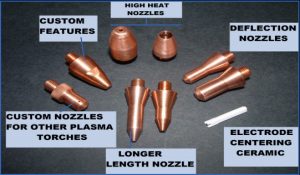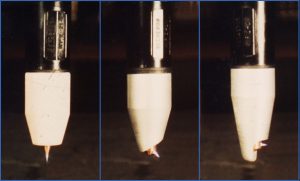The plasma welding process was introduced to the welding industry in 1964 as a method of bringing better control to the arc welding process in lower current ranges. Today, plasma retains the original advantages it brought to industry by providing an advanced level of control and accuracy to produce high quality welds in miniature or precision applications.
The plasma process is equally suited to manual and automatic applications. It has been used in a variety of operations ranging from high volume welding of strip metal, to precision welding of surgical instruments, to automatic repair of jet engine blades, to the manual welding of kitchen equipment for the food and dairy industry.
How Plasma Welding Works:
A plasma is a gas which is heated to an extremely high temperature and ionized so that it becomes electrically conductive. The plasma arc welding process uses this plasma to transfer an electric arc to a work piece. The metal to be welded is melted by the intense heat of the arc and fuses together.
The system requires a power supply and welding torch. In the torch an electrode is located within a torch nozzle having a small opening at the tip. A pilot arc is initiated between the torch electrode and nozzle tip. Gas is fed through the nozzle where the pilot arc heats the gas to the plasma temperature range and ionizes it. The gas emerges from the nozzle in the form of a jet, hotter than any chemical flame or conventional electric arc. The main welding arc transfers to the work piece through this column of plasma gas.
Plasma gases are normally argon. The torch also uses a secondary gas, argon, argon/hydrogen or helium which assists in shielding the molten weld puddle thus minimizing oxidation of the weld.
By forcing the plasma gas and arc through a constricted orifice, the torch delivers a high concentration of heat to a small area. With suitable equipment the process produces exceptionally high quality cuts on a variety of materials.
Plasma Welding Features & Benefits:
F: Protected electrode
B: Protected electrode allows for less electrode contamination. This is especially advantageous in welding .materials that out gas when welded and contaminate the unprotected GTAW electrode.
F: Length of arc benefit due to arc shape and even heat distribution
B: Arc stand off distance is not as critical as in GTAW. Gives good weld consistency. No AVC needed in 99% of distribution applications, sometimes even with wirefeed.
F: Arc transfer is gentle and and consistent
B: Provides for welding of thin sheet, fine wires, miniature components where the harsh GTAW arc start would damage the part to be welded.
F: Stable arc in welding
B: Reduces arc wander. Arc welds where it is aimed. Allows and arc starting tooling in close proximity to weld joint for optimum heat sinking.
F: Minimal high frequency noise in welding
B: Minimal high frequency noise once pilot arc started, thus plasma can be used with NC controls. Another benefit lies in welding applications involving hermetic sealing of electronic components where the GTAW arc start would cause electrical disturbances possibly damaging the electronic internals of the component to be welded.
F: Arc energy density reaches 3 times that of TIG
B: Causes less weld distortion and smaller welds. Gives high welding speeds
F: Weld times as short as .005 seconds
B: Extremely short and accurate weld times possible for spot seconds welding of fine wires, accurate weld times combined with precision motion devices provide for repeatable weld start/stop positions.
F: Equipment options offer up to 10,000 Hz
B: Offers a wide range of pulsing options for varied, pulsing applications.
F: Low amperage art welding (as low as 0.05 amp)
B: Allows welding of miniature components or good control in downsloping to a weld edge.
F: Arc diameter chosen via nozzle orifice
B: This feature assists in predicting the weld bead size.
Plasma Welding Features, Benefits & Applications
Features & Benefits:
P Protected electrode, offers long times before electrode maintenance (usually one 8 Hr Shift)
L Low amperage welding capability (as low as 0.05 amp)
A Arc consistency and gentle arc starting produce consistent welds, time after time
S Stable arc in arc starting and low amperage welding
M Minimal high frequency noise issues, HF only in pilot arc start, not for each weld
A Arc energy density reaches 3 times that of GTAW. Higher weld speeds possible
W Weld times as short as 5 msecs (.005 secs)
E Energy density reduces heat affected zone, improves weld quality
L Length of arc benefit due to arc shape and even heat distribution
D Diameter of arc chosen via nozzle orifice
Metals that plasma can weld include stainless, heat resistant and other steels, titanium, Inconel, Kovar, zircalloy, tantalum, copper, brass, gold and silver.
Applications:
The benefits of the plasma process offers two prime benefits: Increased welding speed and improved weld quality. Plasma is excellent for welding wires, tubes, strips, sheets, and all miniature, medium and large components requiring precision welding. In many applications, many of the unique advantages of plasma combine to benefit the welding process.
Wire Welding: The plasma process can gently yet consistently start an arc to the tip of wires or other small components and make repeatable welds with very short weld time periods.
Strip Metal Welding: The plasma process provides the ability to consistently transfer the arc to the workpiece and weld up to the edges of the weld joint. In automatic applications no Arc Distance Control is necessary for long welds and the process requires less maintenance to the torch components. This is especially advantageous in high volume applications where the material outgases or has surface contaminants.
Sealed Components: Medical and electronic components are often hermetically sealed via welding. The plasma process provides the ability to;
1. Reduce the heat input to the part
2. Weld near delicate insulating seals
3. Start the arc without high frequency electrical noise which could be damaging to the electrical internals
Precision Instruments: Many instruments require welds of great accuracy. Plasma welding, with its control and precision, provides the ability to make these critical welds.
Other Plasma Welding Applications
Surgical Instruments, Needles, Wires, Light Bulb Filaments, Thermocouples, Probes, Pressure and Electrical Sensors, Bellows, Seals, Cans, Enclosures, Microswitches, Valves, Electronic Components, Motors, Batteries, Miniature Tube to Fitting/Flange, Food and Dairy Equipment, Tube Mill Applications, Tool Die & Mold Repair.
Comparison of GTAW & Plasma Welding Energy Input
Test Parameters: Manual welding, no clamping device, Cr/Ni steel, 0.102″ thickness; all values determined with measuring instruments.
| GTAW: |
125 Amps |
12 Volts |
10.24 |
I.P.M. |
| Plasma: |
75 Amps |
18 Volts |
13.38 |
I.P.M. |
| Heat Input: |
V x A x 60
Speed in cm/min |
| GTAW: |
12 x 125 x 60
Speed in cm/min |
|
| = 3.46 KJ |
|
| Heat Input: |
18 x 75 x 60
34 cm/min |
|
| = 2.38 KJ |
|
In addition to the fact that a higher weld speed is possible, the lower heat input brings the following advantages:
- Less stress in welded component
- Less tempering color with Cr/Ni steels
- Lower risk of damaging any heat sensitive parts adjacent to the weld joint

 There are times however when “standard” parts do not allow you to complete a particularly difficult welding task. PWS has in stock or can build-to-suite almost any customer nozzle requirement.
There are times however when “standard” parts do not allow you to complete a particularly difficult welding task. PWS has in stock or can build-to-suite almost any customer nozzle requirement.